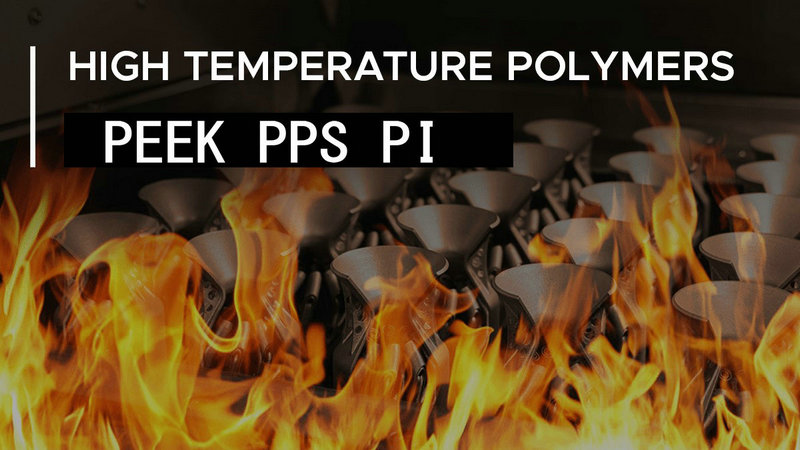
Introduction:
Introduction:In today's fast-paced era of technological development, advancements in materials science have brought significant changes to many fields. High-temperature engineering plastics play a crucial role in this, excelling in harsh environments with high temperatures, pressures, and strong corrosion. Notable examples include Polyphenylene Sulfide (PPS), Polyether Ether Ketone (PEEK), and Polyimide (PI).
What are the characteristics and applications of these three popular high-temperature engineering plastics?
Polyphenylene Sulfide (PPS)
Firstly, let's talk about Polyphenylene Sulfide (PPS). This is a crystalline, high-performance thermoplastic. It boasts exceptional heat resistance with a melting point of around 285°C and a heat distortion temperature generally around 260°C. This means it can operate steadily for long periods in environments exceeding 200°C, easily withstanding high-temperature challenges. Additionally, its chemical stability is impressive; many chemicals, such as strong acids, bases, and organic solvents, have little effect on it. Hence, PPS is very useful in chemical plants where corrosive substances are prevalent. PPS also has good electrical properties, maintaining excellent insulation performance even in hot and humid conditions, ensuring the normal operation of electronic devices.
However, PPS does have some drawbacks, particularly its relatively low toughness, making it prone to brittleness under significant impact. To address this, scientists often reinforce PPS with materials like glass fiber or carbon fiber, significantly enhancing its mechanical properties and enabling it to better handle complex working conditions. In practical applications, PPS is highly versatile. In the automotive industry, it is commonly used to make engine components such as intake manifolds. In the electronics and electrical field, crucial parts like connectors and coil bobbins are often made of PPS.
Polyether Ether Ketone (PEEK)
Polyether Ether Ketone (PEEK) is a semi-crystalline, high-performance specialty engineering plastic known for its remarkable properties. Its outstanding heat resistance is evident, with a melting point of about 343°C and a continuous-use temperature exceeding 250°C. This allows PEEK to maintain stable performance in high-temperature environments, whether facing the intense heat of engines in the aerospace industry or enduring complex thermal conditions in industrial manufacturing. PEEK also has excellent mechanical properties, with high strength to withstand substantial external forces without easily deforming or breaking. Its toughness allows it to absorb energy effectively during impacts, preventing fractures. Furthermore, its excellent wear resistance ensures it remains in good condition despite prolonged friction and wear.
PEEK's good self-lubricating properties are another highlight, effectively reducing friction and wear, thereby significantly extending the lifespan of components. For instance, in automotive manufacturing, PEEK parts can maintain efficient and stable operation over long periods, reducing maintenance and replacement frequency and costs. In the medical device field, PEEK is often used to manufacture artificial joints and other components. Its self-lubricating properties improve joint mobility and extend service life, providing better treatment outcomes for patients.
PEEK's applications in the medical field are extensive due to its biocompatibility, strong mechanical properties, and chemical corrosion resistance. Many medical devices, such as artificial joints and spinal fusion devices, are made from PEEK. In aerospace, PEEK is highly valued for making aircraft engine components and wing structures, contributing to lighter and better-performing aircraft.
Polyimide (PI)
Finally, let's discuss Polyimide (PI). This is a class of high-performance engineering plastics with outstanding heat resistance, capable of short-term use at temperatures as high as 500°C, with a continuous-use temperature range of 250-300°C. PI exhibits high strength and rigidity, able to withstand significant pressure and tensile forces without structural failure. Additionally, PI's excellent insulation properties make it an ideal insulating material in high-temperature environments.
In the electronics industry, PI is often used to manufacture electronic components that operate in high-temperature conditions, such as circuit boards and insulation films. In aerospace, PI is used to make high-temperature structural components, ensuring the safety of aircraft under extreme conditions.
Conclusion
In summary, Polyphenylene Sulfide (PPS), Polyether Ether Ketone (PEEK), and Polyimide (PI) each have their unique strengths. They shine in automotive, electronics, medical, and aerospace fields, continually driving technological advancements.